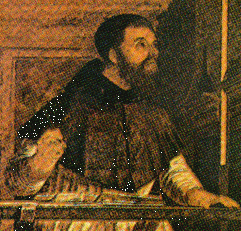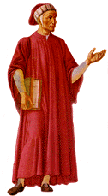Levels of Interpretation in Dante
This passage from Paul is often credited with the beginning of allegorical interpretations of scripture:
Galatians 4:24-31

"These things may be taken figuratively, for the women represent two covenants. One covenant is from Mount Sinai and bears children who are to be slaves: This is Hagar. Now Hagar stands for Mount Sinai in Arabia and corresponds to the present city of Jerusalem, because she is in slavery with her children. But the Jerusalem that is above is free, and she is our mother. For it is written:
Be glad, O barren woman,
who bears no children;
break forth and cry aloud,
you who have no labor pains;
because more are the children of the desolate woman
than of her who has a husband.
Now you brothers, like Isaac, are children of promise. At that time the son born in the ordinary way persecuted the son born by the power of the Spirit. It is the same now. But what does Scripture say? 'Get rid of the slave woman and her son, for the slave woman's son will never share in the inheritance with the free woman's son.' Therefore, brothers, we are not children of the slave woman, but of the free woman."
Paul takes a story from Genesis in which Abraham is commanded by his wife Sarah to put away her slave and his concubine, Hagar, who had born to them a boy Ishmael. Sarah, who has given birth to her own son, Isaac, no longer wants Hagar and Ishmael to vie for Abraham's attention. Paul takes this story and interprets it as an allegory of life under the Old Testament law versus life under New Testament grace.
Augustine
Augustine, as well, held a view of scripture that examined passages from an allegorical perspective. As a result, he argued that truths might be intended by God in scripture that the human author had not intended:

"So when one person has said 'Moses thought what I say', and another 'No what I say', I think it more religious in spirit to say 'Why not rather say both, if both are true?' And if anyone sees a third or fourth and a further truth in these words, why not believe that Moses discerned all these things? For through him the one God has tempered the sacred books to the interpretations of many who could come to see a diversity of truths."
-- The Confessions 12.30 (41)

Dante
Dante himself wrote on the nature of interpretation in his early work Il Convivio (The Banquet). There, he reflected the traditional medieval understanding that interpretation can take place on four levels: the literal, the allegorical, the moral, and the anagogical.
- The literal represents the most obvious reading.
- The allegorical tends to understand the literal set of actions as being symbolic of certain other principles.
- The moral draws ethical principles from the literal action.
- The anagogical applies the principle to the final state of the believer.
Another famous letter to Can Grande Della Scala, which some scholars discount as Dante's, also argues that this same system can be applied to The Divine Comedy.
According to the letter, Dante's Divine Comedy should be understood as a work that literally describes the afterlife - hell, purgatory, and heaven. Yet the work is really more concerned with the present state of humans: "the end of the whole and of the part is to remove those living in this life from the state of misery and lead them to the state of felicity."
Definition from Convivio: "This is that sense which does not go beyond the strict limits of the letter"
Examples from Convivio:
- Orpheus' lyre makes wild animals tame and trees and stones attract towards him.
- Christ ascends the Mount of Transfiguration with three of the twelve apostles.
- "When the people of Israel went up out of Egypt, Judea was made holy and free."
Examples from Letter to Can Grande:
- The Exodus of Israel from Egypt
- DivineComedy as "the state of souls after death."
Definition from Convivio: "This is disguised under the cloak of such stories, and is truth hidden under a beautiful fiction."
Examples from Convivio: Example one represents the ability of song to tame cruel hearts and to influence those without rational reflection.
Examples from Letter to Can Grande:
- Our Redemption in Christ
- Divine Comedy as "man as by good or ill deserts, in the exercise of the freedom of his choice, he becomes the exercise of the freedom of his choice, he becomes liable to rewarding or punishing justice."
Definition from Convivio: "This sense is that for which teachers ought as they go through writings intently to watch for their own profit and that of their hearers."
Examples from Convivio: Example two teaches the ethical principle that "for the most secret affairs we ought to have few companions."
Examples from Letter to Can Grande:
- The conversion of the soul from sin to grace.
- "To remove those living in this life from the state of misery and lead them to the state of felicity."
Definition from Convivio: "This occurs when a writing is spiritually expounded which even in the literal sense by the things signified likewise gives intimation of higher matters belonging to the eternal glory."
Examples from Convivio: Example three can be understood to represent "that when the soul issues forth from sin she is made holy and free as a mistress of herself."
Examples from Letter to Can Grande:
- Departure of the soul from the sinful state of this world to the eternal, graced state of eternity.
- Literal and anagogical are the same.
So, if not according to Dante himself, at least according to a tradition closely associated with him, The Divine Comedy can be understood as much about this life as the next.
